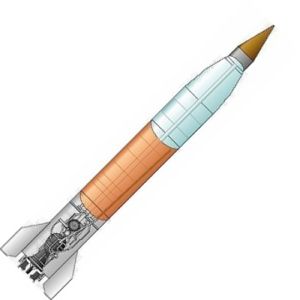
Home - Search - Browse - Alphabetic Index: 0- 1- 2- 3- 4- 5- 6- 7- 8- 9
A- B- C- D- E- F- G- H- I- J- K- L- M- N- O- P- Q- R- S- T- U- V- W- X- Y- Z
G-1
 Groettrup G-1 |
AKA: R-10;R-4. Status: Study 1947. Payload: 1,000 kg (2,200 lb). Thrust: 313.00 kN (70,365 lbf). Gross mass: 18,400 kg (40,500 lb). Height: 14.40 m (47.20 ft). Diameter: 1.65 m (5.41 ft).
On 22 May 1947 he first group of 234 specialists was given the task of designing a 600 km range rocket (the G-1/R-10). Work had begun on this already in Germany but the initial challenge in Russia was that the technical documentation was somehow still 'in transit' from the Zentralwerke. The other obstacle was Russian manufacturing technology, which was equivalent to that of Germany at the beginning of the 1930's. Nevertheless the team completed the G-1 draft project and defended it on 28 December 1948.
The State Commission found the G-1 to be superior to Korolev's R-2 design in many respects. However the Russian designers managed to convince the government to put the R-2 rather than the G-1 into production by arguing that the manufacturing technology of the G-1 could not be mastered immediately by Soviet Union. Several of the design concepts (integrated propellant tanks, radio-controlled cut-off, forward liquid oxygen tank) were however used by the Russians in their R-2 and R-5 rockets.
In comparison with the V-2 the G-1 used a separable warhead, duraluminum alloy construction throughout the airframe, integrated propellant tanks, and radio-controlled cut-off for improved accuracy. The result was a reduction in missile empty weight to 1.87 metric tons from 3.17 metric tons for the V-2 and a 600 km range vs 300 km for the V-2. Later improvements would increase the range to 810 km with a target accuracy ellipse of 2 km x 3 km. The G-1 was given the secret designation R-4 and overt designation R-10 by the Russians.
Maximum range: 600 km (370 mi).
Family: IRBM. Country: Russia. Agency: Groettrup Design Bureau. Bibliography: 394, 476, 86.
1947 May 22 - . LV Family: Groettrup. Launch Vehicle: G-1.
- Groettrup G-1 design ordered - .
Nation: Russia.
Related Persons: Glushko,
Groettrup,
Korolev.
The G-1 was Groettrup's first design after the German engineering team had been moved to Russia. The first group of 234 specialists was given the task of designing a 600 km range rocket (the G-1/R-10). Work had begun on this already in Germany but the initial challenge in Russia was that the technical documentation was somehow still 'in transit' from the Zentralwerke. The other obstacle was Russian manufacturing technology, which was equivalent to that of Germany at the beginning of the 1930's. The Germans worked at two locations, NII-88 (Korolev OKB) and Gorodmlya Island to complete the design of the G-1. Other groups of Germans worked at Factory 88 (R-1 production) and Factory 456 (Glushko OKB / engine production).
1947 Sept - . LV Family: Groettrup. Launch Vehicle: G-1.
- G-1 design completed by Groettrup team. - .
Nation: Russia.
Related Persons: Glushko.
The selected design was 14.2 m x 1.62 m, 18,400 kg gross weight, empty weight 1,960 kg, 32,000 kgf thrust, LOX/alochol propellants, 20 atm pressure thrust chamber, integral tanks, turbine driven by exhaust gases, control section in back, radio beam guidance, 900 km range, accuracy - 25% in a 1.0 km box.
1948 December 28 - . LV Family: Groettrup. Launch Vehicle: G-1.
- G-1 and R-2 designs evaluated by Soviet State Commission. - .
Nation: Russia.
Related Persons: Korolev.
The team defended the G-1 draft project on 28 December 1948. The State Commission found the G-1 to be superior to Korolev's R-2 design in many respects. However the Russian designers managed to convince the government to put the R-2 rather than the G-1 into production by arguing that the manufacturing technology of the G-1 could not be mastered immediately by Soviet Union. Several of the design concepts (integrated propellant tanks, radio-controlled cut-off, forward liquid oxygen tank) were however used by the Russians in their R-2 and R-5 rockets.
Back to top of page
Home - Search - Browse - Alphabetic Index: 0- 1- 2- 3- 4- 5- 6- 7- 8- 9
A- B- C- D- E- F- G- H- I- J- K- L- M- N- O- P- Q- R- S- T- U- V- W- X- Y- Z
© 1997-2019 Mark Wade - Contact
© / Conditions for Use